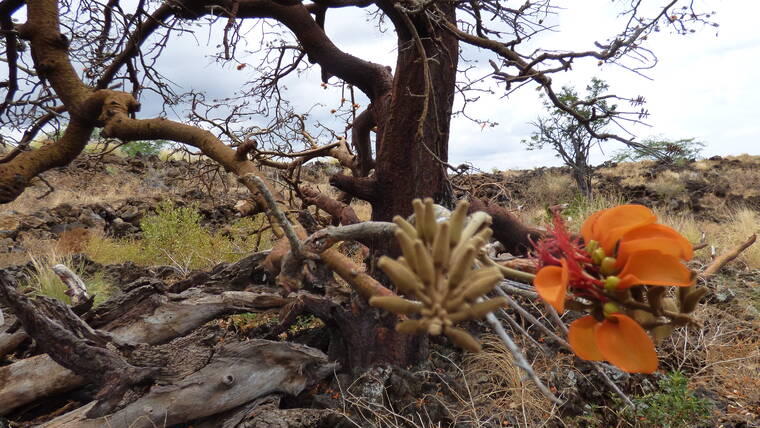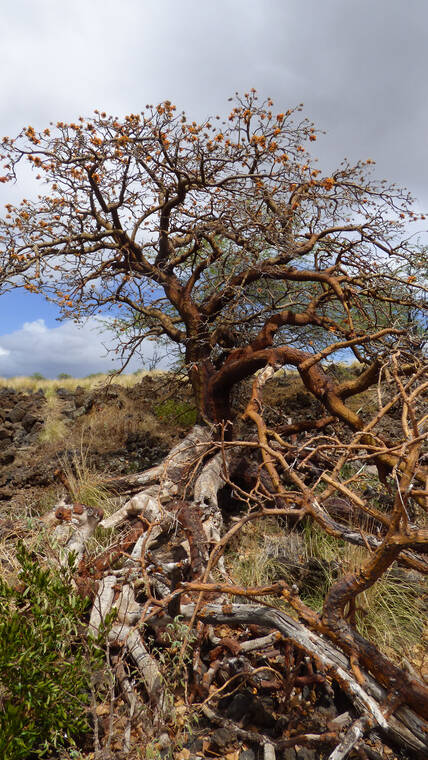A second biological control agent is moving closer to entering the battle against the erythrina gall wasp to enhance survival of endemic wiliwili trees across Hawaii.
The state Department of Agriculture, with the support of the Department of Land and Natural Resources and University of Hawaii, moving forward with its proposal for the statewide field release of Aprostocetus nitens, a host specific natural enemy of the erythrina gall wasp, Quadrastichus erythrinae.
Releasing the parasitoid will complement a previously introduced biocontrol agent, Eurytoma erythrinae, in reducing the wasp’s negative impact on wiliwili trees, according to a final environmental assessment published Feb. 8 finding the action would have no significant impacts.
The erythrina gall wasp, native to Africa, has attacked and killed hundreds of erythrina trees in Hawaii, including the endemic wiliwili (E. sandwicensis), a keystone species of the native lowland dry forests of Hawaii. The wasp was first discovered on Oahu in 2005.
Initially, the state tried to fight the wasp by injecting priority trees with systemic pesticide until 2008 when E. erythrinae, a natural enemy of the wasp in Africa, was released in Hawaii following rigorous testing and approved permits, according to the final EA.
Despite the successes of E. erythrinae in controlling the erythrina gall wasp (EGW), damage by the wasp on reproductive parts of wiliwili and young seedlings persist.
“Extensive experiments show A. nitens and E. erythrinae have different feeding preferences, controlling EGW on different parts of the plant. The release of A. nitens will complement E. erythrinae in suppressing infestations of EGW, and will improve the survival success of wiliwili, an ecologically and culturally important Hawaiian tree species,” the final environmental assessment reads.
A. nitens is a small parasitoid, measuring 1.1 to 1.7 millimeters long, that is shiny black in color with a dark metallic green tinge and yellow gaster, antennae, and legs. The wings are transparent with brown venation.
A specific timeline for the release of A. nitens was not included in the final environmental assessment, a required step in the process for obtaining federal and state permits. The document said an application for the final permits allowing the importation of the parasitoid have already been submitted to the state Department of Agriculture’s Plant Quarantine Branch.
Release sites on all islands will be selected according to the availability of erythrina trees infested with erythrina gall wasp, according to the final EA. Initial releases will begin on Oahu, Maui, and Hawaii islands.
The draft EA for the action was released in December 2019 and garnered comment from five entities, all in support of the release of the parasitiod to protect wiliwili trees.
“As a practitioner of native forest restoration, I strongly support the release of a second biocontrol to help reduce the impacts of the Erythrina gall wasp on our native wili wili. Our staff assisted with the release of the first biocontrol agent for the fall [sic] wasp, and I’m hopeful this second species will complement the positive impacts the initial release had. I support further research, funding, and utilization of biocontrol as a non-chemical tool to support our native species and restore resilience and function to Hawaiian ecosystems,” Andrea Buckman, of Makawao, Oahu, wrote in comments on the draft EA included in the final EA.
Email Chelsea Jensen at cjensen@westhawaiitoday.com.









